BACKPACK SAFETY
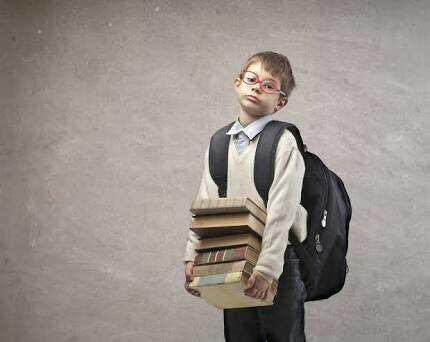
image source
There are backpacks of all sizes, colors, fabrics and shapes that help children of all ages to express their own personal style. And, when used correctly, they are incredibly practical.
Many of them have multiple compartments that help children organize when they load their books and papers from home to school and vice versa. Compared with shoulder bags, wallets that hang on one side of the body and handbags, backpacks are better because the stronger muscles of the body - those of the back and abdomen - support the weight that is loaded in them.
When placed correctly, the weight contained in the backpack is distributed evenly throughout the body, and shoulder and neck injuries are less frequent than when carrying briefcases or handbags.
But, for practices that are the backpacks, they can put too much tension on muscles and joints and cause pain if they are overloaded or used incorrectly.
causes of wrong backpacks
Although there are many factors that can cause back pain, such as excessive participation in sports or physical exercise, the adoption of inappropriate postures when sitting and spending long periods of inactivity, some children have a back ache because they are carrying all of them your books, school supplies and various personal items throughout the day. But most pediatricians and physiotherapists recommend that children carry no more than 10% to 15% of their body weight in backpacks.
Knowing how a heavy backpack can affect a child's body helps to understand how the back works. The vertebral column is composed of 33 bones called vertebrae and between adjacent vertebrae there are discs that act as natural buffers.
When a heavy backpack, such as one full of books, is placed incorrectly on the shoulders, the force of the loaded weight can pull the child backwards. To compensate, the child will bend forward at the hips or arching the back, which can cause the spine to contract forcefully. Excessive weight can cause some children to develop shoulder, neck and back pain.
Children who carry the backpack only on one shoulder, something quite common, because they believe that carrying it like this is better or simply because they find it easier to put it on, they can end up leaning to one side to compensate for the additional weight. They can develop back and dorsal pain and strain the shoulders and neck excessively.
The incorrect use of the backpack can also lead to the adoption of inappropriate postures. Girls and young children are at greater risk of injury when they use backpacks because they are smaller and carry heavier loads in proportion to their body weight.
Likewise, the backpacks provided with tight straps or straps that are stuck in the shoulders can interfere in the circulation and compress some nerves. This type of straps can contribute to tingling, tingling, loss of sensation and weakness in the arms and hands.
Very heavy or bulky backpacks not only cause back injuries. Other security issues to consider are the following:
Children who carry bulky backpacks often do not realize how much room these occupy and can hit other people with the backpack when turning around a corner or when moving through narrow spaces, such as the bus corridor or school bus.
Children often injure themselves by tripping over bulky backpacks or when they fall on them.
Transporting a heavy backpack modifies the way children walk and increases the risk of falls, especially on stairs or other places where the backpack is easy to unbalance the student.
Acquire a safe backpack
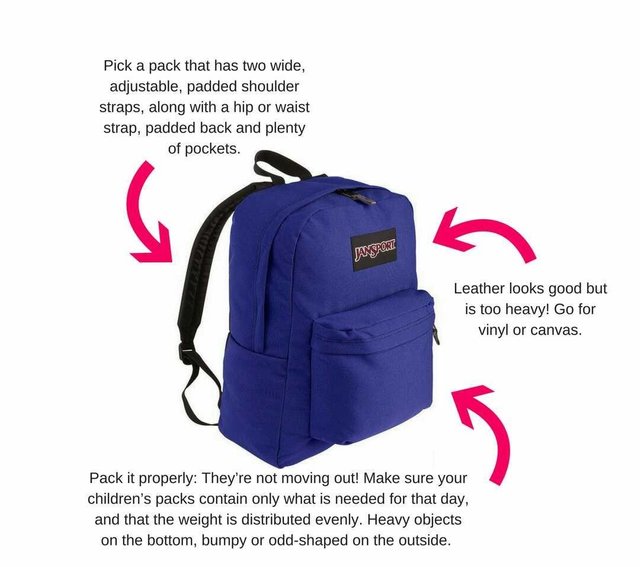
image source
Despite their potential problems, backpacks are an excellent tool for children when they use them correctly. But, before buying your son that new backpack that is fashionable and he has been claiming for a while, look carefully at its structure.
Use a lightweight backpack so you do not add extra weight to the load the child has to carry (for example, even though leather or leather backpacks look good, they weigh more than traditional canvas backpacks)
two wide and padded shoulder pads ; shoulder pads that are too narrow can dig into the shoulders
a padded back , which is not only more comfortable, but also protects children from pricking with sharp edges or pointed objects (pencils, rulers, notebooks, etc.) stored inside the backpack
a belt at waist height , which helps distribute weight more evenly throughout the body
multiple compartments , which help distribute weight more evenly
Although backpacks with wheels (which look like small luggage bags) can be good options for students who have to carry really heavy loads, they are extremely difficult to climb up the stairs or drag on snow. Consult your child's study center before buying a backpack with wheels; Many schools do not allow them because they represent a risk of stumbling in the corridors.
Use backpacks correctly
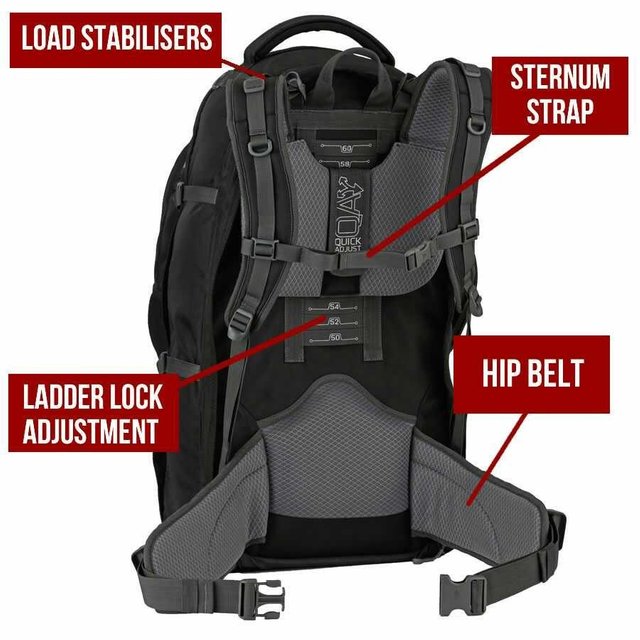
image source
To help your child avoid injury when using a backpack, do the following:
Lighten the load. No matter how well designed a backpack is, pediatricians and physiotherapists recommend that children carry backpacks that, once loaded, do not exceed 10% to 15% of their body weight, although carrying less weight is always better. If you do not know how much is 10% to 15%, use the bathroom scale (for example, a backpack of a child weighing 36.3 kilos [80 pounds] should never exceed 3.6 to 5.4 kilos [ 8 to 12 pounds]).
Use and put on your backpack correctly. Make sure your child uses both shoulder pads. Shoulder bags, those that are crossed over the chest or those that have a single lorrea, are not effective in distributing the weight and can force the muscles excessively. Also, tighten the straps well so that the backpack is stuck to the child's body. The backpack should rest evenly in the middle of the back, instead of hanging and resting on the buttocks.
Help your child with safety
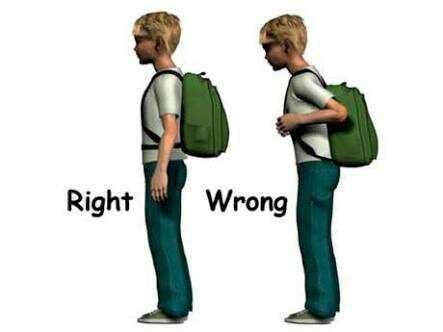
image source
The important responsibility of low loading the backpack and doing it safely lies entirely with the children:
Encourage your child to use the school locker or desk during the day instead of walking the books in the backpack throughout the day.
Make sure your child does not carry unnecessary items in the backpack - laptops, cell phones, and video games can add extra pounds to the backpack.
Your encourage your child to bring home only the books he needs to do homework or study at night.
Ask him how homework is organized. A very heavy backpack every Friday could mean that the child postpones homework for the weekend, overloading the backpack unnecessarily.Grabbing the backpack in the proper way before loading it can also help children avoid back injuries. As with any heavy object, your child should bend their knees and grab the backpack with both hands before placing it on their shoulders.
Use all compartments of the backpack, placing heavier objects, such as textbooks, closer to the center of the back.
.png)
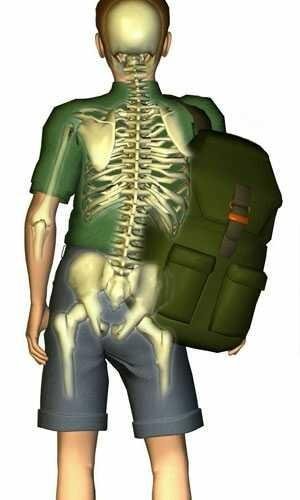

Could you please replace your first image so that we can support you. Steemiteducation does not support posts with pictures with watermarks.
Okay... Thanks alot... Corrections have been made
Congratulations! This post has been upvoted from the communal account, @minnowsupport, by stevendion from the Minnow Support Project. It's a witness project run by aggroed, ausbitbank, teamsteem, someguy123, neoxian, followbtcnews, and netuoso. The goal is to help Steemit grow by supporting Minnows. Please find us at the Peace, Abundance, and Liberty Network (PALnet) Discord Channel. It's a completely public and open space to all members of the Steemit community who voluntarily choose to be there.
If you would like to delegate to the Minnow Support Project you can do so by clicking on the following links: 50SP, 100SP, 250SP, 500SP, 1000SP, 5000SP.
Be sure to leave at least 50SP undelegated on your account.